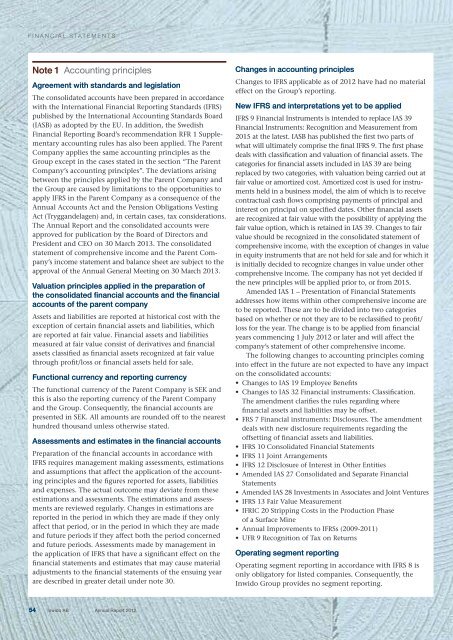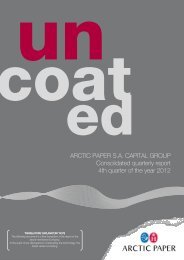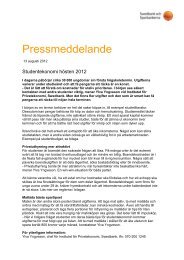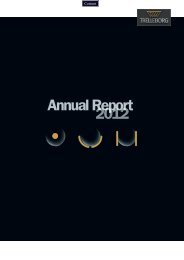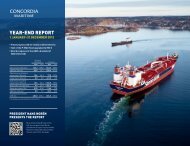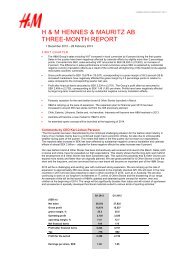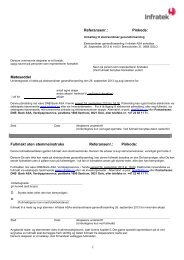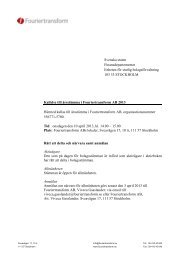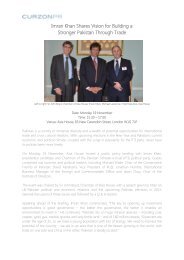Annual Report 2012 - Inwido
Annual Report 2012 - Inwido
Annual Report 2012 - Inwido
Create successful ePaper yourself
Turn your PDF publications into a flip-book with our unique Google optimized e-Paper software.
FINANCIAL STATEMENTS<br />
Note 1 Accounting principles<br />
Agreement with standards and legislation<br />
The consolidated accounts have been prepared in accordance<br />
with the International Financial <strong>Report</strong>ing Standards (IFRS)<br />
published by the International Accounting Standards Board<br />
(IASB) as adopted by the EU. In addition, the Swedish<br />
Financial <strong>Report</strong>ing Board’s recommendation RFR 1 Supplementary<br />
accounting rules has also been applied. The Parent<br />
Company applies the same accounting principles as the<br />
Group except in the cases stated in the section “The Parent<br />
Company’s accounting principles”. The deviations arising<br />
between the principles applied by the Parent Company and<br />
the Group are caused by limitations to the opportunities to<br />
apply IFRS in the Parent Company as a consequence of the<br />
<strong>Annual</strong> Accounts Act and the Pension Obligations Vesting<br />
Act (Tryggandelagen) and, in certain cases, tax considerations.<br />
The <strong>Annual</strong> <strong>Report</strong> and the consolidated accounts were<br />
approved for publication by the Board of Directors and<br />
President and CEO on 30 March 2013. The consolidated<br />
statement of comprehensive income and the Parent Company’s<br />
income statement and balance sheet are subject to the<br />
approval of the <strong>Annual</strong> General Meeting on 30 March 2013.<br />
Valuation principles applied in the preparation of<br />
the consolidated financial accounts and the financial<br />
accounts of the parent company<br />
Assets and liabilities are reported at historical cost with the<br />
exception of certain financial assets and liabilities, which<br />
are reported at fair value. Financial assets and liabilities<br />
measured at fair value consist of derivatives and financial<br />
assets classified as financial assets recognized at fair value<br />
through profit/loss or financial assets held for sale.<br />
Functional currency and reporting currency<br />
The functional currency of the Parent Company is SEK and<br />
this is also the reporting currency of the Parent Company<br />
and the Group. Consequently, the financial accounts are<br />
presented in SEK. All amounts are rounded off to the nearest<br />
hundred thousand unless otherwise stated.<br />
Assessments and estimates in the financial accounts<br />
Preparation of the financial accounts in accordance with<br />
IFRS requires management making assessments, estimations<br />
and assumptions that affect the application of the accounting<br />
principles and the figures reported for assets, liabilities<br />
and expenses. The actual outcome may deviate from these<br />
estimations and assessments. The estimations and assessments<br />
are reviewed regularly. Changes in estimations are<br />
reported in the period in which they are made if they only<br />
affect that period, or in the period in which they are made<br />
and future periods if they affect both the period concerned<br />
and future periods. Assessments made by management in<br />
the application of IFRS that have a significant effect on the<br />
financial statements and estimates that may cause material<br />
adjustments to the financial statements of the ensuing year<br />
are described in greater detail under note 30.<br />
Changes in accounting principles<br />
Changes to IFRS applicable as of <strong>2012</strong> have had no material<br />
effect on the Group’s reporting.<br />
New IFRS and interpretations yet to be applied<br />
IFRS 9 Financial Instruments is intended to replace IAS 39<br />
Financial Instruments: Recognition and Measurement from<br />
2015 at the latest. IASB has published the first two parts of<br />
what will ultimately comprise the final IFRS 9. The first phase<br />
deals with classification and valuation of financial assets. The<br />
categories for financial assets included in IAS 39 are being<br />
replaced by two categories, with valuation being carried out at<br />
fair value or amortized cost. Amortized cost is used for instruments<br />
held in a business model, the aim of which is to receive<br />
contractual cash flows comprising payments of princi pal and<br />
interest on principal on specified dates. Other financial assets<br />
are recognized at fair value with the possibility of applying the<br />
fair value option, which is retained in IAS 39. Changes to fair<br />
value should be recognized in the consolidated statement of<br />
comprehensive income, with the exception of changes in value<br />
in equity instruments that are not held for sale and for which it<br />
is initially decided to recognize changes in value under other<br />
comprehensive income. The company has not yet decided if<br />
the new principles will be applied prior to, or from 2015.<br />
Amended IAS 1 – Presentation of Financial Statements<br />
addresses how items within other comprehensive income are<br />
to be reported. These are to be divided into two categories<br />
based on whether or not they are to be reclassified to profit/<br />
loss for the year. The change is to be applied from financial<br />
years commencing 1 July <strong>2012</strong> or later and will affect the<br />
company’s statement of other comprehensive income.<br />
The following changes to accounting principles coming<br />
into effect in the future are not expected to have any impact<br />
on the consolidated accounts:<br />
• Changes to IAS 19 Employee Benefits<br />
• Changes to IAS 32 Financial instruments: Classification.<br />
The amendment clarifies the rules regarding where<br />
financial assets and liabilities may be offset.<br />
• FRS 7 Financial instruments: Disclosures. The amendment<br />
deals with new disclosure requirements regarding the<br />
offsetting of financial assets and liabilities.<br />
• IFRS 10 Consolidated Financial Statements<br />
• IFRS 11 Joint Arrangements<br />
• IFRS 12 Disclosure of Interest in Other Entities<br />
• Amended IAS 27 Consolidated and Separate Financial<br />
Statements<br />
• Amended IAS 28 Investments in Associates and Joint Ventures<br />
• IFRS 13 Fair Value Measurement<br />
• IFRIC 20 Stripping Costs in the Production Phase<br />
of a Surface Mine<br />
• <strong>Annual</strong> Improvements to IFRSs (2009-2011)<br />
• UFR 9 Recognition of Tax on Returns<br />
Operating segment reporting<br />
Operating segment reporting in accordance with IFRS 8 is<br />
only obligatory for listed companies. Consequently, the<br />
<strong>Inwido</strong> Group provides no segment reporting.<br />
54<br />
<strong>Inwido</strong> AB | <strong>Annual</strong> <strong>Report</strong> <strong>2012</strong>


